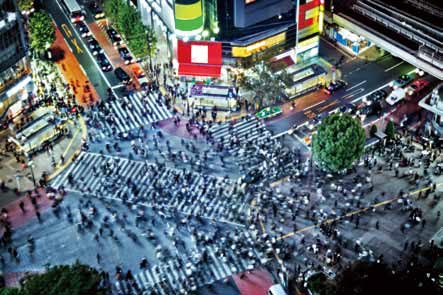Play Nice
Different vendors take different approaches, but the underlying concept is the same. Classifying different rules based on accuracy helps. According to Bharadwaj, there are three categories:
1. Moving objects: people counting, line crossing, zone entry/exit;
2. Static/semi-static objects: object removal, unattended object, dwell time detection (not based on face detection), loitering, crowd counting, object classification; and
3. Special rules: camera tampering, PTZ tracking of moving/stationary objects, ALPR, face detection.
Solutions for the first and third categories are mature, Bharadwaj said. “With the second, we believe more R&D investment is needed for a foolproof solution that works in all situations to surface.” However, Li feels that the question is not about whether an application is ready, but rather if a particular supplier has a product that can work robustly in different environments.
There are four VCA rules that most users are familiar with, namely people counting, directional detection, camera tampering detection and object removal. “The concept can be easily communicated to customers, and the benefits are easily understood,” said Jukka Riivari, CEO of Mirasys.
People Counting
The largest marketfor people counting is retail, Bharadwaj said. “Presently, most retail locations do not have a way to measure footfall traffic and correlate it with sales numbers. A real-life scenario is one in which a store has counting systems installed at all entrances, aisles and exits. These systems can provide various statistics about flow rate, occupancy and other information that can help optimize operations.” In terms of operational efficiency, people counting helps stores maximize staffing levels at both peak- and low-traffic periods, said Steve Gorski, GM for the Americas, Mobotix. “Hospitality is another vertical that also finds significant value through the use of VCA.”
The traditional method for retail counting was highly inaccurate and costly, requiring extensive wiring and many sensors, Lim added. “New top-down intelligent video devices come fully packaged. For chain stores looking to collect data centrally, IP network connectivity also saves a lot of money. Crowd counting for traffic flow in shopping malls is also a growing trend.”
 Accurate people counting requires good processing power. “More often than not, multiple cameras are needed for a wide door/passage way. These cameras need to function as a single integrated sensing entity and generate a single count. It is also important to handle overlap between camera views to avoid over/under counting,” Bharadwaj said.
Accurate people counting requires good processing power. “More often than not, multiple cameras are needed for a wide door/passage way. These cameras need to function as a single integrated sensing entity and generate a single count. It is also important to handle overlap between camera views to avoid over/under counting,” Bharadwaj said.
People counting is very valuable for indoor usage, especially in conjunction with access control. However, the greatest potential lies in commercial and retail settings where people want to know how many people are standing in a certain aisle at a certain time. For security and safety applications, there is increased use of crowd density detection, allowing for an alarm if a train platform reaches, for example, 80 percent of its capacity. Line checking, such as in airports, is another area that can greatly improve operational efficiency, Otterspeer said. “One of the things that can reduce false alarms is head detection. The shape of a human head and its relation to the shoulder is always a certain geometry. Detecting that greatly reduces false alarms from dogs or other animals.”
With the right camera placement and good software, you can do high-quality counting anywhere, Li said. “More sophisticated counting applications can be used for queue management to determine average waiting times.”
Counting and crowd management are slightly different, Lim cautioned. “Counting is expected to be more than 90-percent accurate while crowd management looks at the speed of a crowd formation and area of formation. Count accuracy in crowd management is usually not expected to be more than 85 percent.”
For Coastalwatch , people counting is most practical from a high-mounted camera in an area where background noise is less likely, said Tim Chandler, President of CoastalCOMS Division. “Our focus is to assign a risk variable to a risk index — the ‘count' or number of people is assessed to indicate that the number of people has significantly increased or decreased over a predefined amount of time. Our system ends up reporting 'load' rather than 'count,' which works best in beach areas where safety is a concern.”
Directional Detection
Directional detection and tampering detection are basic functions that many cameras include and most customers enable, Otterspeer said.
“Directional movement detection is used for triggering alerts when a person or vehicle is moving in an area and direction that they should not be moving in. This is used, for example, in protection of critical infrastructure and in airports,” Ashani said.
Real-life scenarios for directional detection involve perimeter surveillance and wrong-way movement detection for vehicles and people, Bharadwaj added. “This is a motionbased algorithm; false alarms arise when the line drawn includes objects such as trees that move due to wind.”
Directional detection can also be applied to beaches as a further indication of risk. “The ability to draw a virtual line in the sand and see if folks are stepping across the line to move into or out of the water is useful, as it can modify a risk calculation's results,” Chandler said. “The idea is to support the risk manager with useful decision support metrics that they can evaluate in real time, especially for remote or unmanned areas of responsibility.”
Directional movement detection can be very accurate, so long as the environment is not overly crowded. Outdoor scenarios are more challenging as there are environmental conditions that can lead to false positives or negatives, Ashani said. “Modern VCA algorithms are able to robustly handle outdoor scenarios in many common cases. Another challenge is the ability to distinguish between target types. For example, the system can fail to distinguish between a group of people and a slow moving vehicle if the algorithm is not sophisticated enough.”
Typical sources of false alarms are moving shadows, changing lights and incorrect object/target classification. Each of these can be minimized by developing additional algorithmic components, Ashani said.
Tampering Detection
Like with all video analytics, tampering can be a simple application, Li said. “The system can tell if someone has sabotaged the camera or covered the lens. More sophisticated systems can also tell if the system can see clearly. So even if the camera has not been tampered with but has lost focus or can't see because it's raining too hard or if the camera has moved due to vibrations, the system will let the operator know.”
Tampering detection is a must-have for any surveillance installation. A tampered camera directly defeats the purpose of video surveillance, Bharadwaj said. “Accuracy depends on design. A good solution needs to detect tampering due to camera defocusing, blocked camera and view change. At the same time, it needs to disregard camera shakes/vibrations due to environmental conditions.”
Camera-tampering detection is applicable to any surveillance camera and enhances the operational readiness of cameras in surveillance installations, Ashani said. “For some solutions, camera tampering is not limited to only video loss or image blocking but also detects insufficient lighting or oversaturated images which result in poor video quality.” This application is generally very accurate and generates very few false alarms, Ashani added.
Object Loitering/Removal
Object loitering and object removal are essentially the same thing. The targeted object is identified, but the alarm goes the other way around, Otterspeer said.
At the moment, object removal rules are probably most effective in places where the traffic is not too dynamic, Lim said. “Object loitering is not as magical as some would claim. If a camera is placed over a crowded airport and a crowd forms up covering one another and an unattended bag, there is no way the VCA will work.” Successful applications are likely in museums and exhibitions rather than airports and transport terminals. “I've heard stories about a public transport operator that tried to implement unattended-bag detection for trains, buses and even the stations. It was a complete failure,” Lim added.
Object removal detection is not practical if the object in question is too small, not in a well-lit area or occluded from the view of the camera for very long periods of time, Ashani added. “There was a large warehouse that installed 150 cameras, all of which carried video analytics. The customer wanted to be notified when cargo went missing, and to be able to use forensic search to find the cargo. This was not that difficult,” Otterspeer said. “However, the director of that establishment wanted to know when one little box of a cellular phone went missing, and wanted the system to follow it through all 150 cameras. That was simply not possible — and still isn't — with the current state of the technology.” Once the director was shown how to set up the right detection lines and proper rules, he was still impressed by how much it could help his operations.
Baggage abandoning is a different matter, as the system needs to understand when one object splits into two and establish a connection between the person and baggage.